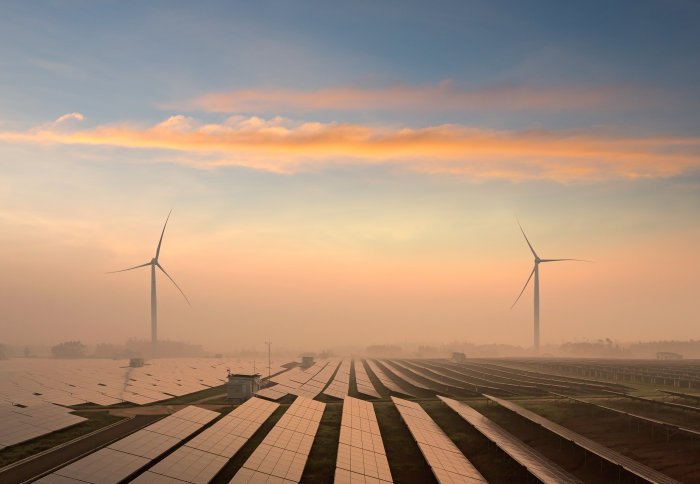Wind and solar power could provide more than a third of Europe’s energy by 2030

By trading energy between countries with different weather patterns, Europe could make the most of wind and solar power.
This conclusion is from a study modelling the future of weather and energy in Europe, which could help plan future continent-wide energy systems and policies that share renewable resources across countries. The models estimate Europe could use renewables for more than two-thirds of its electricity by 2030, with more than one-third coming from wind and solar.
If European countries pool their renewable energy resources, everyone benefits from a cheaper and more secure electricity system, which will ultimately allow wind and solar power to provide a greater share of our energy needs. Dr Iain Staffell
Wind and solar energy in Europe have quadrupled in use between 2007 and 2016. However, both are susceptible to fluctuating weather patterns, raising concerns about Europe’s ability to endure long spells with low winds or overcast skies.
Britain’s current heatwave, for example, has led to a 'wind drought', with July 2018 40% less productive than July 2017 for wind power in the UK.
Now, research led by University College Cork in collaboration with Imperial College London and ETH Zürich suggests that despite the unpredictable nature of wind and solar energy, the European power system can comfortably generate at least 35% of its electricity using these renewables alone by 2030, without major impacts on prices or system stability.
30 years of weather data
The study, published today in the journal Joule, modelled the impact of long-term weather patterns on wind and solar renewable energy technologies across Europe and their impact on electricity sector operation out to the year 2030.
Previously, researchers have used decades of historic weather data to model this variability in wind and solar energy and its effect on markets, but many studies only analyse data from one given year or focus solely on one country or small region.
In the new study, the team used wind and solar data spanning the 30-year period from 1985 through 2014 to analyse electricity system operation across Europe, including power transmission between countries.
With this dataset, the team was able to model how Europe would fare under five different renewable energy scenarios with varying sustainability ambitions, twelve years into the future.
Pooling European resources
Dr Seán Collins from University College Cork, a co-author of the study, said: “When planning future power systems with higher levels of wind and solar generation, one year of weather data analysis is not sufficient. We find that single-year studies could yield results that deviate by as much as 9% from the long-term average at a European level and even more at a country level.”
While the cost of electricity might vary more from one year to the next along with the weather, overall the costs are going down as renewable sources become the cheapest way to produce electricity. Dr Iain Staffell
Co-author Dr Iain Staffell, from the Centre for Environmental Policy at Imperial, added: “If European countries pool their renewable energy resources, everyone benefits from a cheaper and more secure electricity system, which will ultimately allow wind and solar power to provide a greater share of our energy needs.”
By using multiple years the team found that in future scenarios, carbon dioxide emissions and the total costs of generating energy could fluctuate wildly, becoming up to five times more uncertain as weather-dependent resources gain greater traction in the market.
However, they also found that Europe could withstand this variability quite well thanks to its close integration, for example by trading energy between regions and countries with different weather patterns.
Cheaper renewable energy
The team believe their models and data could be used to depict a variety of possible future scenarios to help policymakers better understand the reliability and impact of renewable energy, including the impacts of a shift to 100% renewable electricity systems.
Dr Staffell added: “The world, and especially Europe, is rapidly shifting towards renewable energy sources, so it is important that we develop new tools to help understand the impacts this will have on the day-to-day running of the power system and how much households can expect to pay for clean electricity.
“While the cost of electricity might vary more from one year to the next along with the weather, overall the costs are going down as renewable sources become the cheapest way to produce electricity.”
By making their models and data openly available, the researchers also hope that future work will continue with greater awareness of these long-term weather patterns to accurately depict a more renewable energy-reliant world.
-
‘Impacts of inter-annual wind and solar variations on the European power system’ by Seán Collins, Paul Deane, Brian Ó Gallachóir, Stefan Pfenninger & Iain Staffell is published in Joule.
-
Image credit: Shutterstock/west cowboy
Article supporters
Article text (excluding photos or graphics) © Imperial College London.
Photos and graphics subject to third party copyright used with permission or © Imperial College London.
Reporter
Hayley Dunning
Communications Division